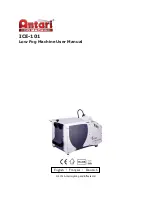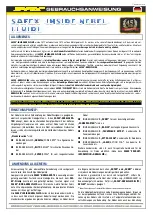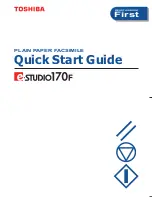
Methods of creating stitching data
[9]-32
Memo (A) It is for the combination data of a curve input and multiple sew.
The data like the figure below (right) is made as shown in the figure below (left) when curves
which pass point 2, point 3, and point 4 after an feed from the home position to point 1 are
combined with multiple sewing and inputs.(Distance=10mm and 2 times of "Frequency")
The distance of the multiple data becomes "It is narrow" the data as shown in figure.
They are not like to make this partially narrow multiple data, to make a constant distance multiple
data as much as possible, please input 2' between 2 and 3 as shown in the figure below (left).
The multiple data as shown in the figure below (right) is made.
Memo (B) It is for the combination data of a curve input and multiple sew.
The data like the figure below (right) is made as shown in the figure below (left) when curves
which pass point 2, point 3, and point 4 after an feed from the home position to point 1 are
combined with multiple sewing and inputs.(Distance=8mm and 4 times of "Frequency")
The data is made in the curve that the fourth curve is different as understood from
figure(fight).
The distance of the multiple data becomes "It is narrow" the data as shown in figure.
When the virtual input point which makes the multiple is requested by the operation, such a
situation like the figure below, the reason for it is to intersect in the multiple.
Moreover, such a situation changes variously depending on the condition of the input point etc. of
"Distance", "Frequency" of the multiple data, and the curve.
Please use a variety of trying.
Summary of Contents for PLK-E Series
Page 2: ......
Page 13: ...Explanations of basic screens keys and operations 3 6...
Page 15: ...Stitching data type and writing No 4 1...
Page 21: ...Reading writing and erasing data floppy disk 5 5...
Page 26: ...Reading writing and erasing data internal memory 6 4...
Page 28: ...7 1...
Page 35: ...Creating simple stitching data 8 6...
Page 39: ...Methods of creating stitching data 9 3...
Page 44: ...Methods of creating stitching data 9 7...
Page 54: ...Methods of creating stitching data 9 15...
Page 58: ...Methods of creating stitching data 9 22...
Page 63: ...Methods of creating stitching data 9 26...
Page 68: ...Methods of creating stitching data 9 30...
Page 72: ...Methods of creating stitching data 9 33...
Page 75: ...Methods of creating stitching data 9 35...
Page 79: ...Methods of creating stitching data 9 38...
Page 86: ...Modification mode 12 5...
Page 89: ...Modification mode 12 7...
Page 94: ...Modification mode 12 11...
Page 99: ...Modification mode 12 15...
Page 104: ...Modification mode 12 19...
Page 111: ...Modification mode 12 25...
Page 115: ...Modification mode 12 28...
Page 122: ...Modification mode 12 34...
Page 126: ...Modification mode 12 37...
Page 133: ...Modification mode 12 43...
Page 138: ...Modification mode 12 47...
Page 143: ...Modification mode 12 51...
Page 148: ...Modification mode 12 55...
Page 155: ...Data conversion mode 13 6...
Page 158: ...Data conversion mode 13 8...
Page 162: ...Data conversion mode 13 11...
Page 166: ...Data conversion mode 13 14...
Page 169: ...Data conversion mode 13 16...
Page 179: ...Data conversion mode 13 25...
Page 204: ...Program mode 16 5...
Page 205: ...Program mode 16 6...
Page 208: ...Program mode list 17 2...
















































